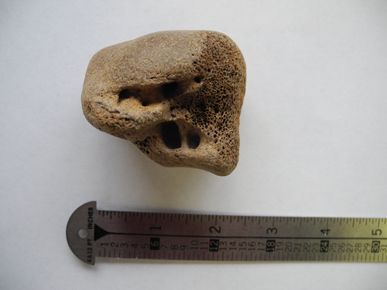More fossil finds by Homer beachcombers have expanded scientists’ knowledge of the animals that lived here during an interglacial period from 27,000 to 55,000 years ago — what’s called stage 3, between the last two Penultimate and Naptowne glaciations. Radiocarbon tests were done for a horse tibia found by Bryan Zak and an unidentified ungulate — hoofed animal — found by this author. A date couldn’t be done on Zak’s fossil because of contamination, but Beta Analytic of Miami got a radiocarbon date for my bone at 32,220 years old, putting it square in a cluster of bones from the stage 3 interglacial period.
Historian and writer Janet Klein said the recent finds have created a sample base large enough to conclude that large animals once lived in the Homer area in a pocket of glacier-free land. Klein and Soldotna geologist Dick Reger gave a talk in March at the Alaska Anthropology Association Meetings.
“What came out of this talk were enough people saying ‘You’ve got 17 or 18 — that’s numerically significant,’” she said. “Every one but one fall into that same time period.”
“It’s coming together. It’s interesting how old bones create this whole picture of life in Homer,” Zak said.
Zak found the tibia from a prehistoric, giant horse seven or eight years ago. He found the blue-tinted bone on the beach below his house near Baycrest Hill in the tide line. A friend, Tony Romeril, identified it as a fossil. He took it to the Pratt Museum and showed it to Betsy Webb, then curator of collections.
“She said, ‘It looks like a horse tibia,’” Zak said. “We opened up the drawer for the prehistoric horse, equus scotti, and it matched almost exactly.”
For my fossil, I have to admit to being embarrassed about finding it, since I’d lost it for years in a bag of bones I had kept from beach walks. Last fall, bone expert Lee Post happened to see it and identified it as a fossil. I loaned the fossil to Klein to be dated.
Klein and Reger showed my bone to scientists at the University of Alaska Fairbanks, but they couldn’t identify it. It could be an ankle or wrist bone or the end of a leg or arm bone. Most likely it’s a hoofed animal like a caribou or moose.
That bone makes at least five different species of fossil animal bones found in the Homer area. Most finds have been woolly mammoth teeth or tusks.
“There’s a reason for that,” Reger said. “The mammoth elements, the molars and the tusk, are very resistant to break up and crushing.”
Other species found include the steppe bison, a carnivore bone, Zak’s horse bone and my ungulate bone. A carnivore bone found by Joyce Robinette had chemistry that indicated the animal had eaten a lot of fish, possibly a seal or a bear. While Zak’s horse bone couldn’t be dated, its presence fits in with what’s known about animals of the stage 3 interglaciation.
“Wooly mammoth, steppe bison and horses always travel together. We call them ‘the Big Three,’” Klein said.
What Reger and Klein don’t know is exactly where the fossil bones come from. None of them have been found where the animal died. The bones have all been pushed down from the Homer bench onto beaches.
“Those pieces are pretty large and heavy. They only move in floods,” Reger said.
Most likely the fossils came from an ice-free area on the edge of Diamond Creek or in the southern Caribou Hills.
“Anywhere in the upper part of that drainage, you could get fossils,” Reger said. “People building house foundations and basements in that area may find something in place or nearly in place.”
The pay day in the fossil hunt would be to find an intact skeleton. In the mean time, be on the lookout for fossils on the beach — or, look in your beach find collections for something you might have overlooked.
“We’re always interested in looking at things if they were found on the Kenai Peninsula,” Klein said. “We don’t want to look at things if they were found in Nome.”
“Maybe more people when they’re walking on the beach are going to be more aware,” Zak said “Aware of how fossil rich our beaches are.”
Michael Armstrong can be reached at
michael.armstrong@homernews.com.
Fossil bone discoveries in Homer to date
Pleistocene finds from interglacial period of about 27,000 to 55,000 years ago:
• Woolly mammoth molar, 39,620 years old
• Woolly mammoth molar, 40,080 years old
• Woolly mammoth molar, 43,500 years old
• Woolly mammoth molar, 46,100 years old
• Woolly mammoth tusk, 27,400 years old
• Woolly mammoth tusk, 28,200 years old
• Woolly mammoth tusk, 31,740 years old
• Woolly mammoth ankle bone, >48,500 years old
• Steppe bison horn cord, >43,500 years old
• Carnivore rib, species unknown, >46,100 years old
• Ungulate bone, species unknown, 32,220 years old
Undated find:
• Horse tibia, contaminated, no date
Find from Naptowne Glaciation, exact origin unknown
• Woolly mammoth tusk, 20,400 years old
All fossils were found on the Homer beach or in creek beds between Diamond Creek and Bishop’s Beach


